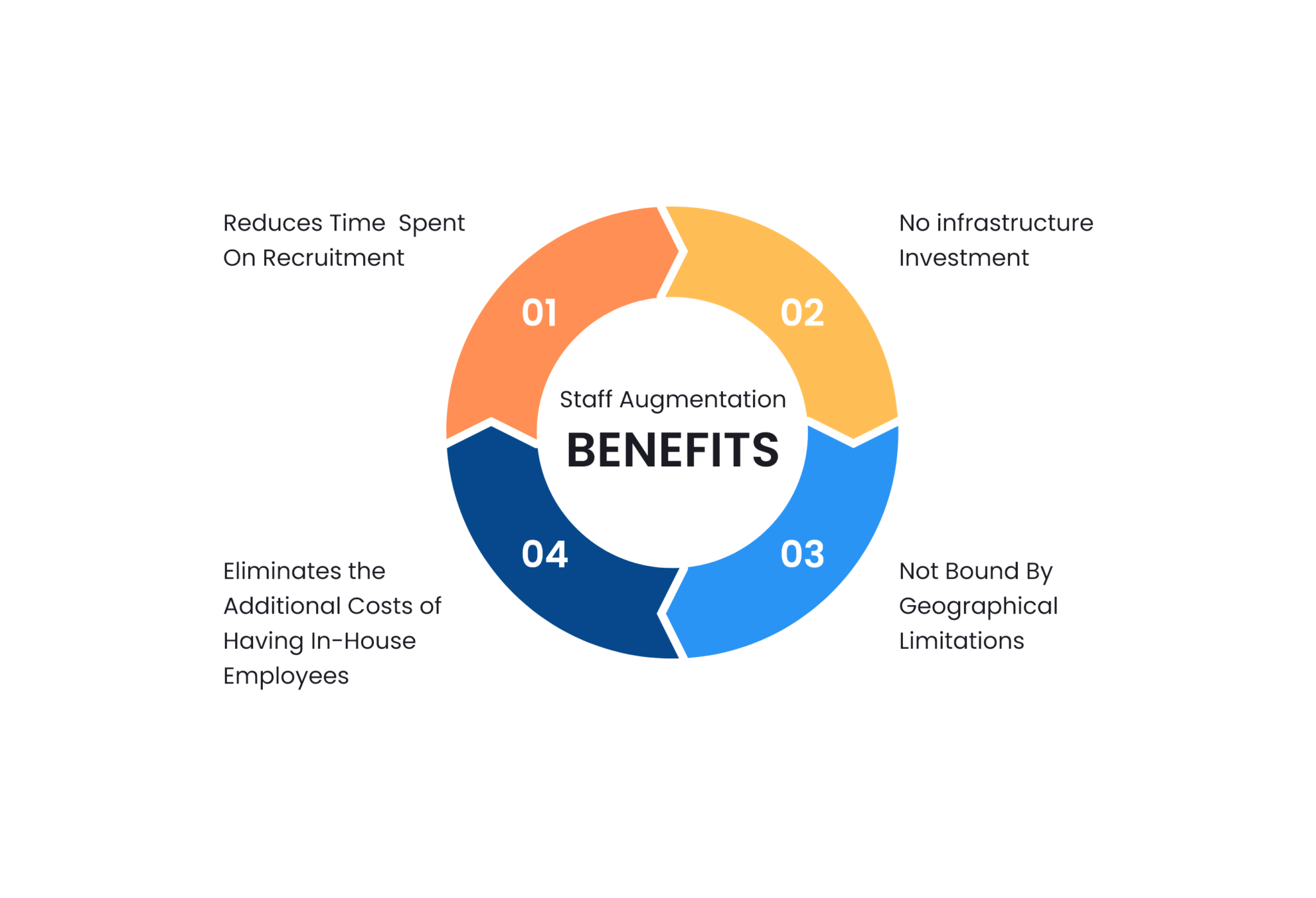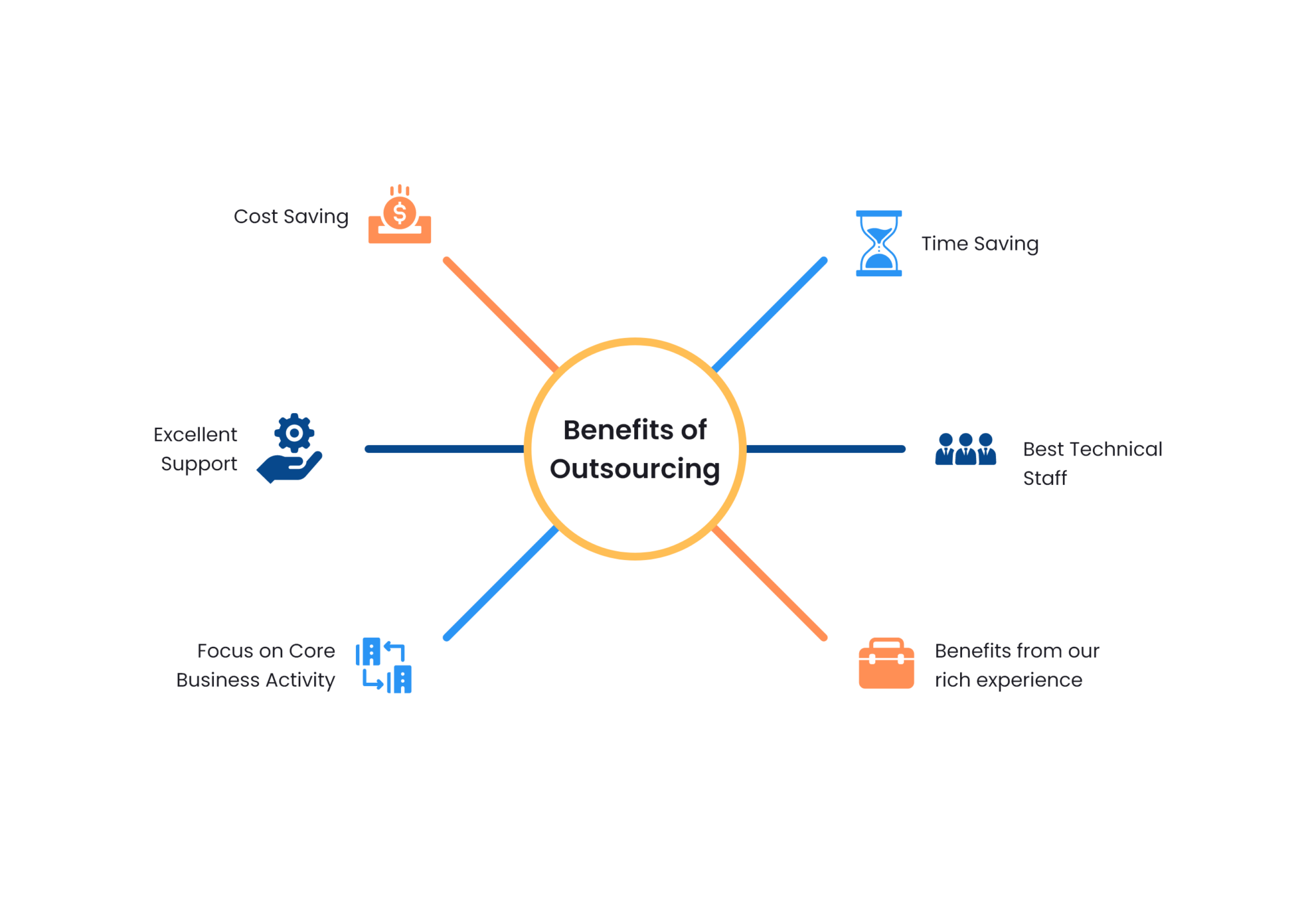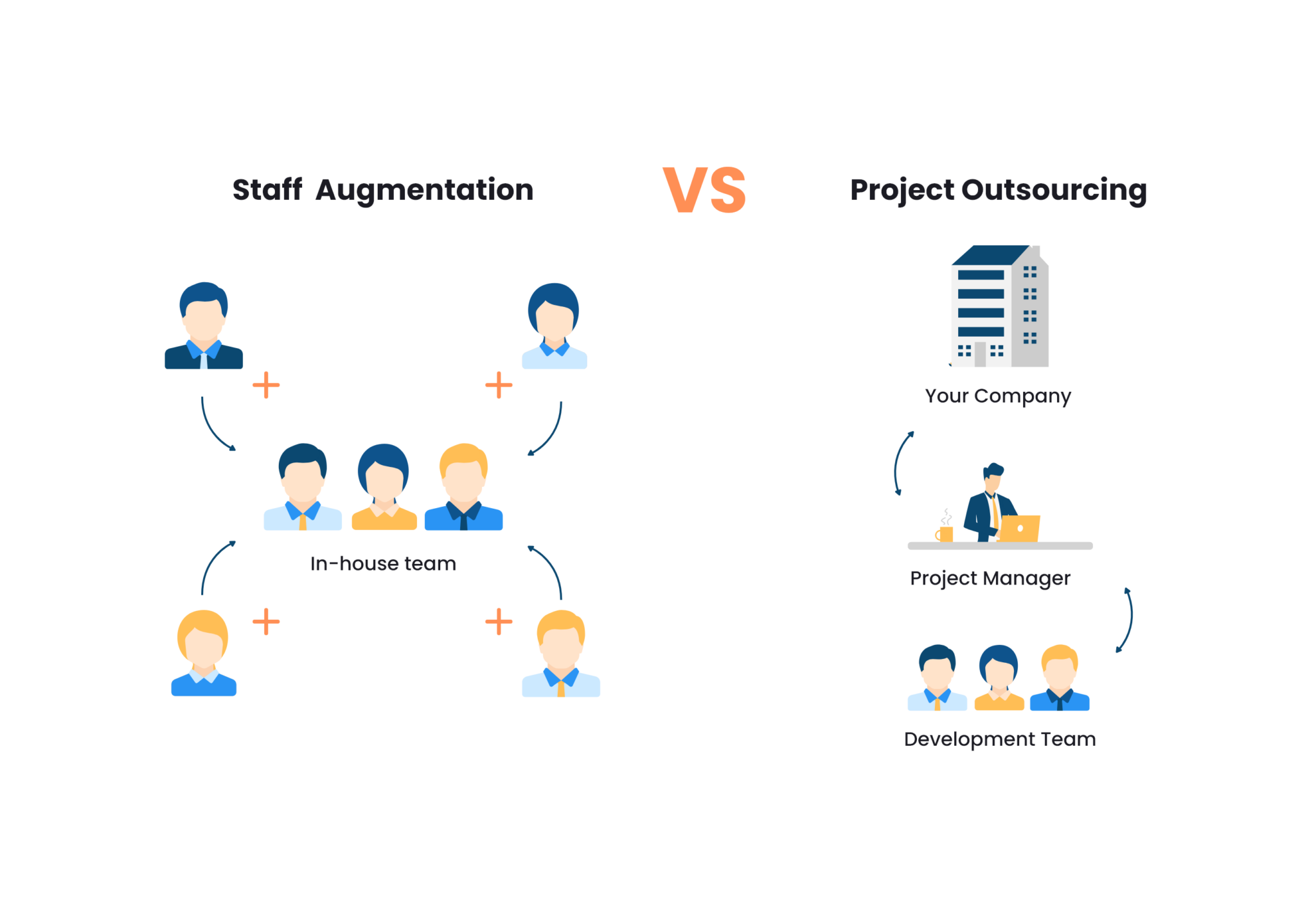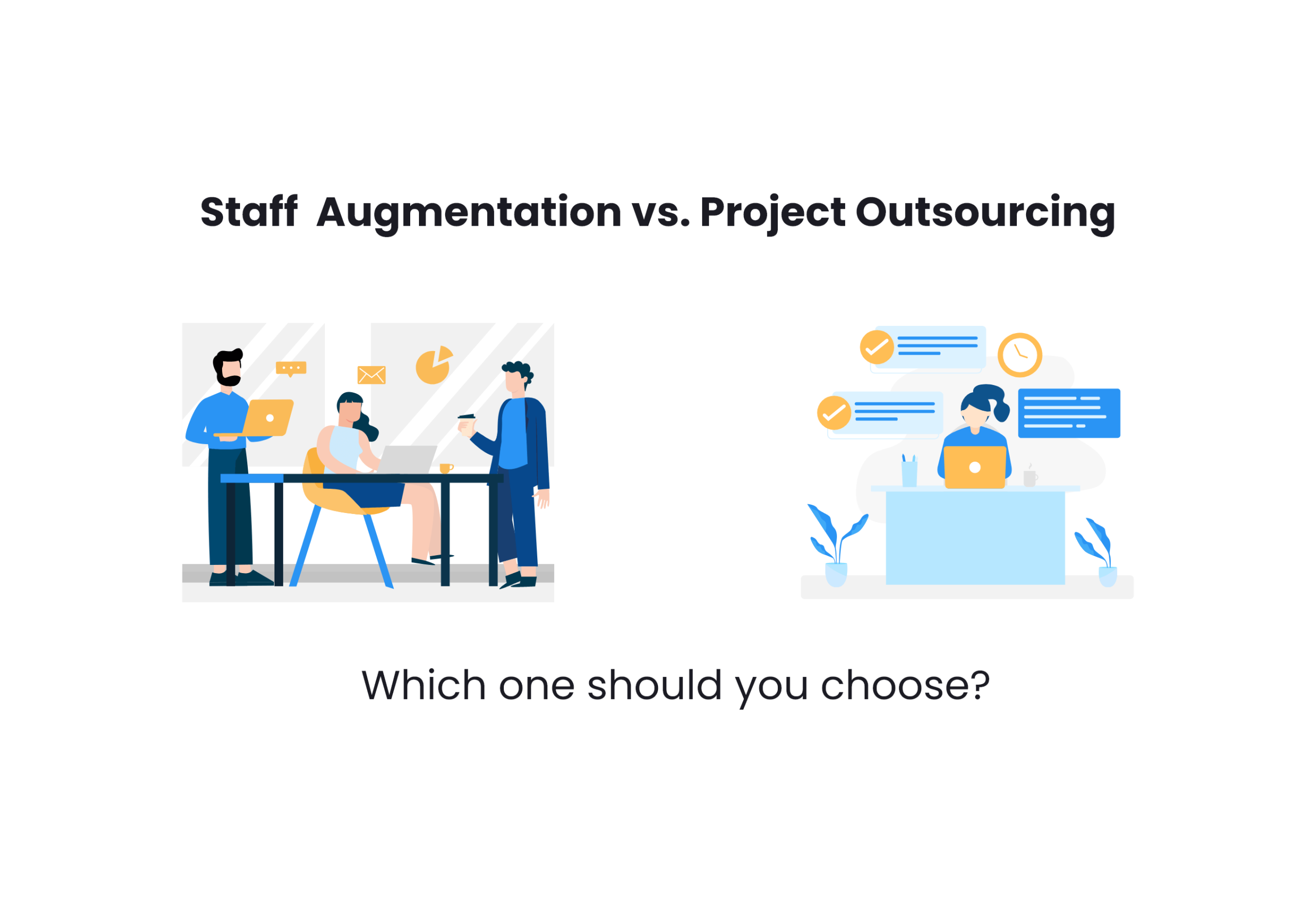Some elements of an organization’s IT requirements, such as system monitoring, data backup, and network administration, are nearly steady. However, new or unanticipated IT initiatives may bring a large amount of labor at once. It’s at this stage that many businesses start debating between staff augmentation vs project outsourcing.
On the other hand, the worldwide IT sector is expected to be worth about $5 trillion in 2021. Asia will also significantly impact the global IT sector, with a share of 32%. And these Statista figures demonstrate just how big the IT sector has become in the modern world. It’s safe to state that IT outsourcing is a lifesaver thanks to its many advantages before going into further detail. Therefore, an increasing number of businesses are delegating their IT duties to third parties. Now, let’s compare project outsourcing with staff augmentation in detail.
Staff Augmentation VS Project Outsourcing
What is Staff Augmentation?
In staff augmentation, a software firm hires external engineers on a Time & Materials contract basis to supplement its own engineers’ skills. Third-party experts who work exclusively on the buyer’s premises for the duration of the project extend the outsourcer’s internal team in practice (or serve as its only members).
Companies save money on recruiting, payroll services, and project execution by using staff augmentation. This model can be readily scaled up or down because it’s a partnership rather than an employment contract. As such, FTEs may be decreased (or increased) promptly as required. Furthermore, this complete shift of responsibility reduces administrative burdens associated with HR and employment. As a result, the outsourcer can devote more time and resources to the core business.

What Is Project Outsourcing?
By collaborating with a remote software company and handing over the project to its team of programmers, you can outsource a dedicated team. Most of the time, it involves much more than simply team augmentation in a collaboration. Software-related services like design and analysis are also included. These include UI/UX design and quality assurance as well.
Due to the vendor’s deep engagement, there is a greater incentive to produce the best possible outcomes than staff augmentation. As a result of all of this, the software company is more than simply a temporary service provider. It is a close and valued partner.

Staff Augmentation VS Project Outsourcing: A Detailed Comparison
Let’s look at a short comparison of the pros and cons of staff augmentation vs project outsourcing to find the answers.
1. Project Management
The outsourcer typically manages the project internally under the staff augmentation model, even though external employees are responsible for certain aspects.
Employing a dedicated team, on the other hand, implies hiring a project manager. And this reduces the buyer’s project management duties while the vendor assumes complete project management responsibility. For the buyer’s convenience, a single point of contact is usually established.
The software provider’s governance system is another advantage of external project management. An experienced software house has already figured out the most effective method of managing IT projects, has a lot of such collaborations in its portfolio, and understands how to get things done on time and within budget.
2. Responsibilities and Cost
Both approaches place the onus on the service provider to find and hire qualified engineers. With dedicated teams, however, the vendor pays for office space, software licensing, gear, utilities, and the training of the staff. Moreover, they take care of the general well-being of software engineers.
What’s on the surface in terms of employment expenditures is only the beginning. The software house is responsible for any costs that go into calculating the total cost of ownership for these types of tasks. Although this endeavor increases employee engagement and reduces attrition, it must be correctly done to be effective.
Project outsourcing has the apparent advantage of lowering costs. According to a Statistics Brain study, 44% of American firms surveyed chose the project outsourcing approach primarily to save costs. Ultimately, the outsourcer benefits from having a motivated and competent workforce because of all of this.
3. Relationship with the Vendor
Without mutual trust and understanding, no business partnership will be successful.
Companies often form more direct and long-term relationships with developers they outsource. When you and your partner work closely together, you better understand your company’s fundamental requirements and problems. Frustration and discomfort are all too often in the workplace when people lack confidence in the people they’re working with.
A relationship with a provider of staff augmentation services is more limited. Also, it essentially boils down to merely delivering resources in the form of a required number of engineers. It is not uncommon for this kind of business connection to end with the last line of code. Thus, it is superficial. Last but not least, the staff augmentation services supplier often shows less concern for your IT project’s eventual success than the other parties involved.
4. Cooperation Kick-Off
Staff augmentation providers often need less time to get up and running than a committed team of programmers.
However, the outsourcer bears some of the burden of identifying the best fit. Buyers should be wary of making assumptions about candidate profiles, abilities, and technical experience required for the project without an expert on their own staff or one on the supplier’s side. The kick-off may take longer and cost more if it doesn’t have this.
When it comes to gathering a dedicated team for each project, the software house has the sole duty of scaling it to meet the customer’s current requirements and guarantee seamless development management. The outsourcer’s job is to determine the project’s scope and functionality rather than to express personal preferences for certain programmers or developers in general.
5. Working and Organizational Culture
Working and organizational culture vary greatly between the two types as well.
Developers in an outsourced team may establish a unique knowledge exchange and collaboration atmosphere by working together in the same office. The staff augmentation approach is typically outclassed when it comes to close friendships, the general environment, and team spirit.
In addition, the software firm ensures that its employees are comfortable at work. Moreover, they get appropriate career development and mentorship and have access to all essential resources. Well, that’s not all. They also ensure that the company’s culture is strengthened.
Engineers in the staff augmentation model may not identify with either party since they know they will be working on another project for a different company sooner or later. And this common cause of demotivation can trigger changes in jobs.
6. Internal Policy
Working with outside contractors also often leads to a shortage (or severe scarcity) of in-house programmers. When you hire engineers solely for the project, you may get caught in a loop because you can’t use the same engineers you used for staff augmentation after the project is over. This means you have to find other developers, introduce them to the company, share domain knowledge, and so on – just to let them go after the project is over. The cycle repeats itself.
7. Insights and Knowledge
Temporary workers also have the drawback of not knowing your company, your previous projects or products, your previous business experience, or your market expertise. This means you can’t count on them to be as proactive or creative as a normal employee.
An additional benefit of using a dedicated outsourced team is that the connection is more personal, allowing the team to know your company better and better understand what you need. This is not the case with staff augmentation.
You can expect innovative software solutions from your business’s software partner.

Treinetic’s Reasons for Believing in Outsourcing
Staff augmentation has certain obvious advantages. It’s a good approach to coping with IT talent scarcity when your company wants quick results with a tight budget but doesn’t have much time to spare. The advantages of adding personnel, on the other hand, diminish in direct proportion to the project’s duration. Working with a remote software house will be more effective and advantageous as the IT project grows in size and complexity.
Companies that specialize in trustworthy, robust, and skilled in managing IT projects stand augmentation are available, as is the case with any other service. And, in some cases, this model may be just what you’re looking for. However, the long-term advantages of a successful IT collaboration are more cost-effective and less stressful for the project, according to our experience. We also must study what big companies prefer in this case. According to Love to Know, even IBM and Dell outsource. And this suggests the effectiveness and pros of outsourcing.
You can concentrate on your company’s core and get cutting-edge outcomes by letting a dedicated, award-winning development team handle your software solution’s design, development, implementation, and maintenance.

